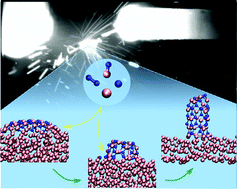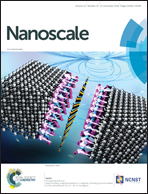Root-growth of boron nitride nanotubes: experiments and ab initio simulations†
Abstract
We have synthesized boron nitride nanotubes (BNNTs) in an arc in the presence of boron and nitrogen species. We find that BNNTs are often attached to large nanoparticles, suggesting that root-growth is a likely mechanism for their formation. Moreover, the tube-end nanoparticles are composed of boron, without transition metals, indicating that transition metals are not necessary for the arc synthesis of BNNTs. To gain further insight into this process we have studied key mechanisms for root growth of BNNTs on the surface of a liquid boron droplet by ab initio molecular dynamics simulations. We find that nitrogen atoms reside predominantly on the droplet surface where they organize to form boron nitride islands below 2400 K. To minimize contact with the liquid particle underneath, the islands assume non-planar configurations that are likely precursors for the thermal nucleation of cap structures. Once formed, the caps are stable and can easily incorporate nitrogen and boron atoms at their base, resulting in further growth. Our simulations support the root-growth mechanism of BNNTs and provide comprehensive evidence of the active role played by liquid boron.



 Please wait while we load your content...
Please wait while we load your content...
